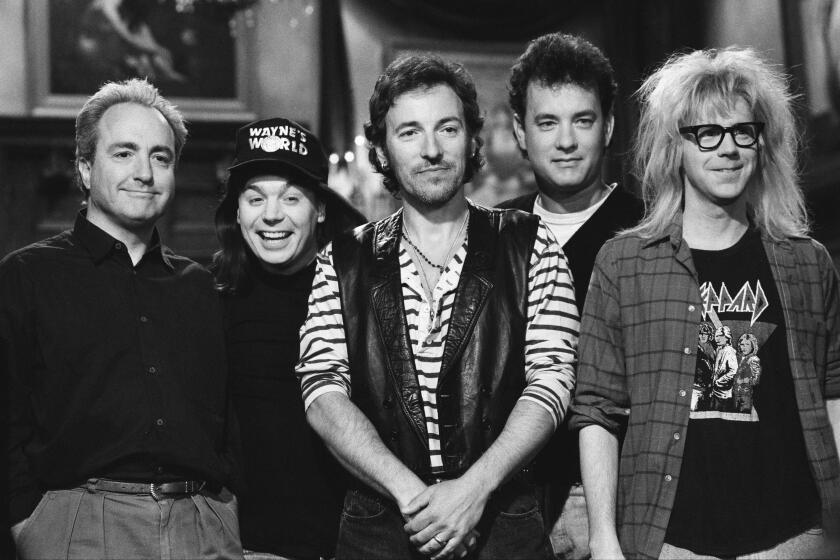Dancing With Mr. D : THE DEVIL: A Biography.<i> By Peter Stanford (Henry Holt: 304 pp., $27.50)</i>
- Share via
Most biographies are about lives that have ended or are soon to end. No exception to this rule, Peter Stanford’s “biography” of the devil is a kind of memorial for a figure who once stood at the center of Christian theology but who exists today only “on the margins, in exorcism rituals, among the mavericks of the Vatican and Islam, and in the fundamentalist theology of the born-again movement.” Despite the title, “Too Soon for an Obituary,” that he gives to the last part of his book, Stanford has written a death notice. What is less clear is whether it is a eulogy or a message of good riddance.
For mainstream Protestants and Catholics, Stanford says, the devil has become an embarrassment. A holdover from a superstitious age that believed in possession and exorcism, the devil has lately become, in the words of the eminent psychologist Henry Murray, “a ludicrous ham actor with no greater part to play in man’s imagination than the vermiform appendix in his gut.” Stanford quotes the Anglican bishop of Durham, David Jenkins, as remarking a few years ago that “if evil is the question, the devil is not necessarily the answer. We ask the right questions but are satisfied with the wrong answers.”
The right question--inescapable for every religion--is, whence evil? If God is good, what accounts for the fractured and hate-filled world in which human beings find themselves? Stanford also quotes approvingly a remark from the contemporary philosopher Leszek Kolakowski, for whom the devil performs the sorry work of “let[ting] God and ourselves off the hook” for the existence of evil. He has been the means by which Christians locate evil outside themselves and thereby spare themselves the arduous work of introspection. And so Stanford seems to agree with the English poet, Percy Bysshe Shelley, who regarded the devil as a figure “invented or adopted” to rescue believers from the “sophism . . . [of] endeavoring to reconcile” God’s omnipotence and benevolence in a “universe where evil and good are inextricably entangled.”
Like Elaine Pagels in her recent book “The Origin of Satan,” Stanford reminds us again and again of how much the devil has contributed to the self-righteousness of those who believe in him. One particularly odious form of Christian intolerance, anti-Semitism, has its roots in the doctrinal attack on the Jews by medieval theologians such as Saint John Chrysostom (who denounced synagogues as “den[s] of vice, the devil’s refuge, Satan’s fortress . . . place[s] to deprave the soul”), and in popular beliefs about Jews as bloodsucking child-killers under orders from Satan. No wonder, then, that Enlightenment philosophers like Voltaire expressed revulsion at the centrality of Satan for the Christian religion, a revulsion that ran so deep that Voltaire even dismissed John Milton’s great poem “Paradise Lost”--at the center of which stands the radiant figure of Satan--as “disgusting fantasy.”
But “The Devil: A Biography” is an interesting book because it is more than an echo of these denunciations. Stanford seems to hesitate about whether the exile of the devil in modern times from serious discussion of psychology and morality has proven to be an advantage or a loss. In fact, his book is less a polemic against Satan than an ambivalent meditation on his waning career.
I suspect this ambivalence is a residue of the author’s childhood. Having received his “Catholic education at the hands of the Irish Christian brothers,” Stanford writes about the devil as if he had been a companion of his youth and seems almost grateful to his teachers, who “provided me with a last glimpse of the by then tattered majesty of a figure who had once haunted the imaginations of countless Christians.”
But why lament the passing of such a moral monster? Why not celebrate his departure? Because, as Stanford points out (paraphrasing a report from the bishop of Exeter in the 1970s), “just because the devil is no longer a widely accepted metaphor in our times . . . the existence of evil cannot be overlooked.” The question raised by this remark, and touched on rather gingerly in Stanford’s book, is whether the metaphors with which we have replaced the devil--the metaphors of psychoanalysis, for example, such as the Freudian unconscious and the Jungian “shadow”--serve to keep us aware of the undiminished human capacity for evil?
Stanford seems unsure how to answer this question, though he hints at a negative answer when he turns to Milton’s “Paradise Lost,” in which the tormented figure of Satan seems to hark back to his Liverpool youth (“one of the few English cities where dog collars and the Angelus are part of everyday life in the streets and in the bars”). Milton’s Satan, he writes, is “a kind of whiskey priest, a disappointed man, a washed-up idealist turned cynical, expelled from the main arena and now sitting on the sidelines doing his damnedest to ruin things.” This devil seethes with resentment at God’s new favorites, the two blissful human creatures in Eden, and cannot abide the idea that the world does not honor his appetites and pride by installing him at the center of paradise.
This is why “Paradise Lost” is a great poem--because sooner or later all human beings experience expulsion from “the main arena,” as part of growing out of childhood and, ultimately, in facing the mortality from which none of us is spared. If we think of Satan as Milton did, as the figure who turns the experience of loss into envy and vengeance, then we may recognize in him a mirror of ourselves. And if he is no longer a living symbol of this universal human capacity for rancor, what symbol has arisen to take his place? What language shall we use to describe ourselves when we do our worst?
These questions will not go away because, as Stanford puts it on the last page of his book, “for all the progress in the world, too many of the conditions that gave birth to Satan in the first place still exist.” The devil may be defunct, but perhaps one should pause before dancing on his grave.
More to Read
Sign up for our Book Club newsletter
Get the latest news, events and more from the Los Angeles Times Book Club, and help us get L.A. reading and talking.
You may occasionally receive promotional content from the Los Angeles Times.










